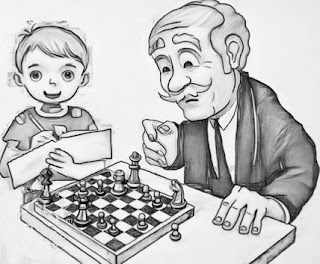In 1947, the major chess activity in California included ia match between Reuben Fine and Herman Steiner who played six game at the homes of sponsors and the Hollywood Chess Group headquarters. Fine won 5-1.George Koltanowski, a chess journalist, moved to Santa Rosa and established the California Chess News magazine. That was the major news coming out of California that year. Today’s game, just an hors d'oeuvre, was played in the finals of the Capitol City Chess Club in Sacramento.
[Event "Capitol City CCC, Sacramento"]
[Site "?"]
[Date "1947.04.??"]
[Round "?"]
[White "J.T. Marianos"]
[Black "S.W. Applegate"]
[Result "0-1"]
[ECO "B01"]
[Annotator "Stickfish 17.1"]
[PlyCount "34"]
[EventDate "1947.??.??"]
{B01: Scandinavian Defense} 1. e4 d5 {One of the oldest defenses, it was
deemed playable in the late 19th century and has been used by such players as
Tarrasch, Spielmann, Tartakower and Alekhine.A regular user in the 1950s was
Yugoslav IM Nikola Karaklajic and in the 1960s it ws used by Bronstein,
women's world champion Nona Gaprindashvili, Larsen, Danish GM Curt Hansen,
Australian GM Ian Rogers and even Viswanathan Anand. Magnus Carlsen has also
given it a try.} 2. exd5 {This is the usual reply. Black has two main replies:
2...Qxd5 (Mieses–Kotrc Variation) and 2...Nf6 (Modern Vriation). The rare 2..
.c6 (Blackburne–Kloosterboer Gambit is thought to be (perhaps wrongly)
unsound and is almost never seen.} Nf6 (2... c6 {Black does get some slight
compensation for the P.} 3. dxc6 Nxc6 4. Nf3 e5 5. Nc3 Nf6 {White 's position
is evaluated as slightly better.}) 3. c4 {This has been played frequently, but
white would do better with 3.d4} c6 {It's odd, but while 2...c6 is evaluated
as slightly better for white, jere it's the recommended move ny engines. Why?
White's last move left him with a poor P-structure; the d-Pawn never moves.} 4.
dxc6 Nxc6 {[%mdl 32]} 5. Nf3 e5 6. Nc3 Bc5 (6... e4 {At once was much better.}
7. Ng5 Bf5 {Black has an excellent position.}) 7. h3 (7. d3 O-O 8. Bg5 Qb6 9.
Qd2 Nh5 10. Na4 Bb4 11. Nxb6 Bxd2+ 12. Kxd2 axb6 {Black is better and
eventually won in Matschewsky,J (1235)-Plotkin,A (1060) Willingen 2005}) (7.
Be2 O-O 8. d3 Bf5 9. O-O Nb4 10. Nxe5 Re8 11. Bf4 Qd4 12. a3 Nxd3 13. Nxd3 Bxd3
14. Qxd3 Qxf4 15. Qf3 Qd2 16. Rab1 b6 {½-½ Sieberg,R-Ueffing,H Dortmund 1987}
) 7... e4 (7... Qb6 {attacking f2 is not so effective. After} 8. Na4 Bxf2+ 9.
Ke2 Nd4+ 10. Kxf2 Ne4+ 11. Ke1 Qg6 {an interesting position has been reached.
It's tricky because white has only one move that keeps the chances equal!} 12.
g4 (12. Nxd4 {is met by} Qg3+ 13. Ke2 exd4 14. Qe1 O-O {and white has to trade
Qs allowing the fork.} 15. Kd1 {runs into} Nf2+ 16. Kc2 Bf5+ 17. d3 Bxd3+ 18.
Kb3 Bxf1+ 19. Nc3 Bxc4+ 20. Kxc4 Rfe8 {which is just awful for white.}) 12...
O-O 13. d3 {with equal chances.}) 8. Qe2 {[%mdl 8192] Thius plausible looking
move loses.} (8. d4 {An absolute must! At keast now black's advantage is only
a modest one.} Bb6 9. c5 exf3 10. cxb6 Qxb6 11. Qxf3 O-O {with sufficient
compensation for the P.}) 8... O-O $19 9. Nh2 {Black is clearly winning.} Nb4
10. Qd1 Re8 {It's surprising how quickly white's position has collapsed after
his 8th move.} 11. Be2 Nd3+ 12. Bxd3 exd3+ 13. Kf1 Qd4 14. Qf3 Bd7 {aiming for
...Bc6.} 15. Nb5 Bxb5 16. cxb5 Re2 17. Qxb7 Qxf2# 0-1




















